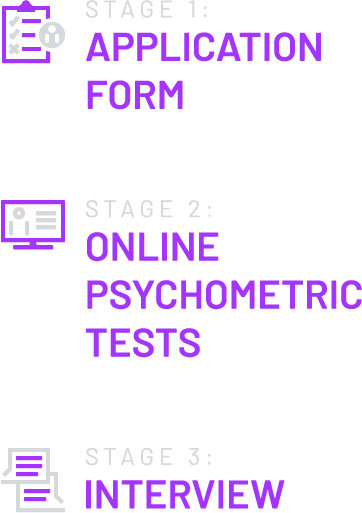Candidate Screening
- What is candidate screening?
- What is high-volume recruitment?
- How do organizations do candidate screening?
- What is the high-volume screening process?
- How can I set up a candidate screening process?
- What are the pre-screening questions to ask candidates?
- How can I hire candidates quickly, or how do I shorten the hiring process?
- Discover Capture
- Related Blogs
- Talk to Talogy
What is candidate screening?
Candidate screening occurs at the start of your selection process. Screening tools are those designed to efficiently remove the candidates with the lowest likelihood of success from your selection process. This allows later steps to be more effective and efficient because the later steps are focused on more viable candidates. Employee selection refers to the entire process for talent acquisition and is what occurs between candidate attraction and onboarding.
What is high-volume recruitment?
A volume hiring process (or high-volume recruitment) refers to a selection process that receives large numbers of applications and/or has many roles to fill. It can range from hundreds to thousands of applications for a similar or lower number of roles. Examples of volume hiring roles may include any entry-level workers, contact center workers, retail associates, or production roles.
Where there are many applications for roles, organizations set up their volume volume hiring processes in multiple stages. These stages are also known as ‘hurdles’, and they are meant to sift out unsuitable applicants and progress candidates who show the best fit to the role’s needs and requirements. When you’re processing many more candidates than you have roles to fill, efficiency and seamless process design are what determine success.
How do organizations do candidate screening?
The candidate screening process usually includes several stages for candidates to complete, which help organizations to find the best person for the job.
There are many ways to narrow the pool of candidates, and organizations can use a variety of methods or tools, such as:
- Pre-screening on basic qualifications
- Job previews, depending on volume level (e.g. a real look at the organization and the role)
- Application forms
- Psychometric tests that measure:
- Cognitive ability
- Personality
- Values
- Situational judgement
- Simulation tests (e.g. simulates real tasks of the role)
- Technical skills
- Safety Interviews (e.g. face to face, over the telephone or via video)
What is the high-volume screening process?
The process of recruitment stages using different tools or methods to sift candidates into smaller numbers is also known as a ‘recruitment funnel’, (see image)
A large number of candidates may start the process in stage one (e.g. the application form), and this number is reduced by passing or rejecting a percentage of candidates at each stage. It is the aim of every selection process to progress candidates that are best suited to the role and organization and sift out other candidates who do not meet key requirements, skills, or characteristics.


How can I set up a candidate screening process?
It is important to set up a robust and fair candidate screensing process. This can be achieved through using multiple stages and tools that have been scientifically proven to work effectively.
It’s important to consider what the job involves and what an organization is looking for in a candidate. Conducting a job analysis will identify the behaviours and competencies required in the role. The job analysis process should serve as the foundation of your selection system. The job analysis identifies the key characteristics or skills needed to succeed in the role, these attributes are what your selection process should measure at every stage in the hiring process.
Once this is complete, it is important to choose how many stages and what types of tools are going to be used to evaluate the candidates. To set up a successful selection process, the following should be considered:
- What stakeholders will be involved and how (i.e. HR, line managers, or current job holders)
- How candidates’ performance will be assessed at each stage and what pass/fail benchmarks will be set
- The time it takes candidates and recruiters to complete each stage
- The cost of any tools or methods
- What the candidate experience of the selection process will be like
- How the process will operate (e.g. proctored or unproctored assessment)


What are the pre-screening questions to ask candidates?
Initial screening questions for candidates in a recruitment process are focused on that candidate’s eligibility to work. For example, do they meet an organization’s basic role requirements or qualifications? These questions should be:
1. Objective: Either they are eligible or they are not – there is no gray area
2. Non-comparative: These questions wouldn’t be used to compare candidates to see who is ‘better’; they are must haves for everyone
3. Job-related: Any question you ask should have a clear link to the requirements of the job.
If pre-screening questions are used at the start of an organization’s recruitment process, They are designed to remove ineligible candidates from the process early. For compliance reasons, these are often focused on basic qualifications needed for the job, such as:
1. Do you have the right to work in that country?
2. Are you legally allowed to work (i.e., are you over a certain age)?
3. Can you work certain days or hours?
Candidates who answer these types of questions incorrectly are rejected at this pre-screening stage.
How can I hire candidates quickly, or how do I shorten the hiring process?
It’s important to keep candidates interested and engaged in the hiring selection process, as well as to hire them quickly to avoid losing them to competitors. Having a lengthy, complicated, or inefficient process is one of the most common reasons that candidates withdraw their application, resulting in organisations missing out on talented individuals. Some ways to hire quickly and effectively are:
- Use easy, quick, and cost-effective tools
- Automate the process, including using technology and online methods, wherever possible.
- Give personalized feedback at each stage to keep candidates interested.
- Save face-to-face stages for later in the process to save time for candidates and recruiters.
- Make sure that candidates are kept up-to-date with the status of their application.
- Combine assessments or stages to save time and make the overall process shorter.
Learn how to maintain a positive candidate experience during high-volume recruitment.




